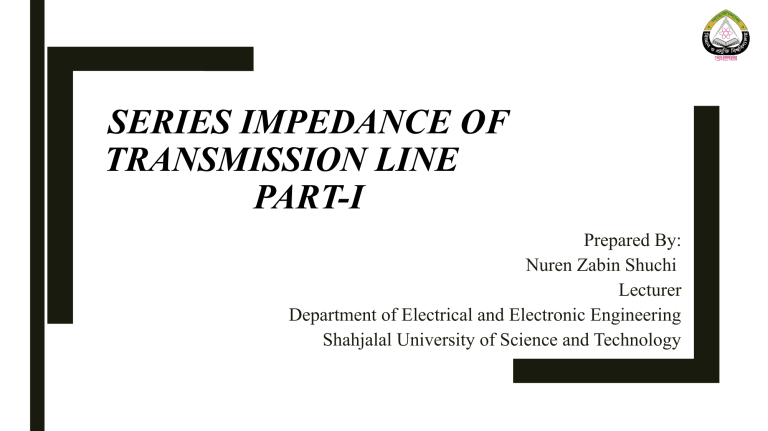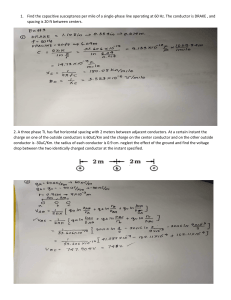
SERIES IMPEDANCE OF TRANSMISSION LINE PART-I Prepared By: Nuren Zabin Shuchi Lecturer Department of Electrical and Electronic Engineering Shahjalal University of Science and Technology ■ Transmission Line Parameters Outline ■ Series Impedance of Transmission Line ■ Resistance of Transmission Lines ■ Factors affecting the Resistance of Transmission Lines Transmission Line Parameters The term Transmission Lines broadly refers to overhead transmission lines and underground cables. The key function of a transmission line is to transfer bulk power between generation sources and load centers. An electric transmission line has four parameters which affect its ability to fulfill its function as part of a power system: 1) 2) 3) 4) Series Resistance Series Inductance Shunt Capacitance Shunt Conductance The series resistance relies basically on the physical composition of the conductor at a given temperature. The series inductance and shunt capacitance are produced by the presence of magnetic and electric fields around the conductors, and depend on their geometrical arrangement. The shunt conductance is due to leakage currents flowing across insulators and air. As leakage current is considerably small compared to nominal current, it is usually neglected. Resistance of Transmission Lines The resistance o f transmission-line conductors is the most important cause of power loss in a transmission line. If DC current is flowing along a solid-round cylindrical conductor, the current is uniformly distributed over its cross-section area and its DC resistance is evaluated by Since the current that flows in the transmission line is alternating, the effective resistance of the transmission line deviates from the DC resistance. The following factors affect the resistance of a transmission line: Frequency Temperature Spiraling & Bundling Resistance of Transmission Lines (cont.) Frequency Effect If AC current is flowing, rather than DC current, the conductor effective resistance is higher due to frequency or skin effect. The frequency of the AC voltage produces a skin-effect due to the nonuniform distribution of the current. As frequency increases, the current tends to go toward the surface (or skin) of the conductor and the current density decreases at the center. Skin effect reduces the effective cross-section area used by the current, and thus, the effective resistance increases. The skin effect is a non-linear effect. Resistance of Transmission Lines (cont.) Temperature Effect The resistivity of any conductive material varies linearly over an operating temperature, and therefore, the resistance of any conductor suffers the same variations. As temperature rises, the conductor resistance increases linearly, over normal operating temperatures, according to the following equation: Figure: Temperature Vs. Resistance curve Resistance of Transmission Lines (cont.) Spiraling & Bundling Stranded Conductors The conductors used for overhead Transmission Line are usually stranded in order to increase the flexibility and to cope up with skin effect. The strands are electrically parallel. Since a stranded conductor is spiraled, each strand is longer than the finished conductor. This results in a slightly higher resistance than the DC resistance. Resistance of Transmission Lines (cont.) Bundled Conductors In high-voltage transmission lines, there may be more than one conductor per phase (bundle configuration) to increase the current capability and to reduce corona effect discharge. Figure: Stranded conductors arranged in bundles per phase of (a) two, (b) three, and (c) four. The phenomenon of ionization of surrounding air around the conductor due to which luminous glow with hissing noise is rise is known as the corona effect. Corona, however, can be reduced by increasing the total conductor surface. By increasing the number of conductors per phase, the total cross-section area increases, the current capacity increases, and the total AC resistance decreases proportionally to the number of conductors per bundle. To maintain the distance between bundle conductors along the line, spacers made of steel or aluminum bars are used. Resistance of Transmission Lines (cont.) Since the factors affecting the resistance include both linear and non-linear effects the effective resistance cannot be calculated simply by adding the DC and AC resistances. The effective resistance of a conductor can be calculated using the following formula: 𝐸𝑓𝑓𝑒𝑐𝑡𝑖𝑣𝑒 𝑅𝑒𝑠𝑖𝑠𝑡𝑎𝑛𝑐𝑒= 𝑃𝑜𝑤𝑒𝑟 𝑙𝑜𝑠𝑠 𝑖𝑛 𝑐𝑜𝑛𝑑𝑢𝑐𝑡𝑜𝑟 2 ¿ 𝐼 ∨¿ ( 𝑜h𝑚) ¿ Where, The power is in watts & I is the rms current in the conductor in amperes. Any Questions?


